Dual PTP1B/TC-PTP Inhibitors: Biological Evaluation of 3-(Hydroxymethyl)cinnoline-4(1H)-Ones
Abstract
1. Introduction
2. Results
2.1. Compounds 1–4
2.2. Inhibitory Effects of Compounds 1–4 towards PTP1B and TC-PTP
2.3. The Effects of Compounds 1–4 on the Body Weight, Food Intake, Glucose Tolerance and Insulin and Leptin Levels in the Blood of Male Rats with HFD-Induced Obesity
2.4. The Effects of Compounds 1–4 on Gene Expression in the Livers of Rats with HFD-Induced Obesity
2.5. Docking Simulation of Compounds 1–4 as PTP1B/TC-PTP Inhibitors
3. Discussion
4. Materials and Methods
4.1. Compound Synthesis
4.2. Biology Studies
4.2.1. The Phosphatases Activity Assay and the Determination of IC50 for Tested Compounds
4.2.2. Animals and the Induction of Obesity
4.2.3. The Determination of Blood Glucose and Hormones Levels and GTT
4.2.4. The Determination of Gene Expression in the Liver of Rats
4.2.5. Statistical Analysis of Biological Experiments
4.3. Computational Details
4.3.1. Used Enzyme Models
4.3.2. Protein and Ligand Structure Preparation
4.3.3. Molecular Docking and MM-GBSA
5. Conclusions
Author Contributions
Funding
Institutional Review Board Statement
Informed Consent Statement
Data Availability Statement
Acknowledgments
Conflicts of Interest
References
- Krishnan, N.; Koveal, D.; Miller, D.H.; Xue, B.; Akshinthala, S.D.; Kragelj, J.; Jensen, M.R.; Gauss, C.M.; Page, R.; Blackledge, M.; et al. Targeting the disordered C terminus of PTP1B with an allosteric inhibitor. Nat. Chem. Biol. 2014, 10, 558–566. [Google Scholar] [CrossRef] [PubMed]
- Villamar-Cruz, O.; Loza-Mejía, M.A.; Arias-Romero, L.E.; Camacho-Arroyo, I. Recent advances in PTP1B signaling in metabolism and cancer. Biosci. Rep. 2021, 41, BSR20211994. [Google Scholar] [CrossRef]
- Yip, S.C.; Saha, S.; Chernoff, J. PTP1B: A double agent in metabolism and oncogenesis. Trends Biochem. Sci. 2010, 35, 442–449. [Google Scholar] [CrossRef]
- Sorokoumov, V.N.; Shpakov, A.O. Protein phosphotyrosine phosphatase 1B: Structure, function, role in the development of metabolic disorders and their correction by the enzyme inhibitors. J. Evol. Biochem. Physiol. 2017, 3, 259–270. [Google Scholar] [CrossRef]
- Köhn, M. Turn and Face the Strange: A New View on Phosphatases. ACS Cent. Sci. 2020, 6, 467–477. [Google Scholar] [CrossRef]
- Liu, R.; Mathieu, C.; Berthelet, J.; Zhang, W.; Dupret, J.M.; Rodrigues, L.F. Human Protein Tyrosine Phosphatase 1B (PTP1B): From Structure to Clinical Inhibitor Perspectives. Int. J. Mol. Sci. 2022, 23, 7027. [Google Scholar] [CrossRef]
- Zhang, Z.Y.; Dodd, G.T.; Tiganis, T. Protein Tyrosine Phosphatases in Hypothalamic Insulin and Leptin Signaling. Trends Pharmacol. Sci. 2015, 36, 661–674. [Google Scholar] [CrossRef] [PubMed]
- Loh, K.; Fukushima, A.; Zhang, X.; Galic, S.; Briggs, D.; Enriori, P.J.; Simonds, S.; Wiede, F.; Tiganis, T. Elevated hypothalamic TCPTP in obesity contributes to cellular leptin resistance. Cell Metab. 2011, 14, 684–699. [Google Scholar] [CrossRef]
- Dodd, G.T.; Xirouchaki, C.E.; Eramo, M.; Mitchell, C.A.; Andrews, Z.B.; Henry, B.A.; Cowley, M.A.; Tiganis, T. Intranasal Targeting of Hypothalamic PTP1B and TCPTP Reinstates Leptin and Insulin Sensitivity and Promotes Weight Loss in Obesity. Cell Rep. 2019, 28, 2905–2922. [Google Scholar] [CrossRef]
- Wang, Y.N.; Liu, S.; Jia, T.; Feng, Y.; Xu, X.; Zhang, D. T Cell Protein Tyrosine Phosphatase in Glucose Metabolism. Front. Cell Dev. Biol. 2021, 9, 682947. [Google Scholar] [CrossRef]
- Liu, P.; Du, Y.; Song, L.; Shen, J.; Li, Q. Discovery of novel, high potent, ABC type PTP1B inhibitors with TCPTP selectivity and cellular activity. Eur. J. Med. Chem. 2016, 118, 27–33. [Google Scholar] [CrossRef] [PubMed]
- Chen, X.; Gan, Q.; Feng, C.; Liu, X.; Zhang, Q. Investigation of selective binding of inhibitors to PTP1B and TCPTP by accelerated molecular dynamics simulations. J. Biomol. Struct. Dyn. 2019, 37, 3697–3706. [Google Scholar] [CrossRef] [PubMed]
- Jin, J.; Ye, X.; Boateng, D.; Dai, K.; Ye, F.; Du, P.; Yu, H. Identification and characterization of potent and selective inhibitors targeting protein tyrosine phosphatase 1B (PTP1B). Bioorg. Med. Chem. Lett. 2019, 29, 2358–2363. [Google Scholar] [CrossRef] [PubMed]
- Rocha, S.; Lucas, M.; Silva, V.L.M.; Gomes, P.M.O.; Silva, A.M.S.; Araújo, A.N.; Aniceto, N.; Guedes, R.C.; Corvo, M.L.; Fernandes, E.; et al. Pyrazoles as novel protein tyrosine phosphatase 1B (PTP1B) inhibitors: An in vitro and in silico study. Int. J. Biol. Macromol. 2021, 181, 1171–1182. [Google Scholar] [CrossRef]
- Brown, A.P.; Saravanan, C.; Devine, P.; Magnifico, M.; Gao, J.; Beaulieu, V.; Ma, F.; Yasoshima, K.; Barnes-Seeman, D.; Yamada, K. Correlation Between Nasal Epithelial Injury and In Vitro Cytotoxicity Using a Series of Small Molecule Protein Tyrosine Phosphatase 1B Inhibitors Investigated for Reversal of Leptin Resistance in Obesity. Int. J. Toxicol. 2017, 36, 303–313. [Google Scholar] [CrossRef]
- Sharma, B.; Xie, L.; Yang, F.; Wang, W.; Zhou, Q.; Xiang, M.; Zhou, S.; Lv, W.; Jia, Y.; Pokhrel, L.; et al. Recent advance on PTP1B inhibitors and their biomedical applications. Eur. J. Med. Chem. 2020, 199, 17376. [Google Scholar] [CrossRef]
- Li, X.; Wang, L.; Shi, D. The design strategy of selective PTP1B inhibitors over TCPTP. Bioorg. Med. Chem. 2016, 24, 3343–3352. [Google Scholar] [CrossRef]
- Li, X.; Niu, M.; Wang, A.; Lu, L.; Englert, U.; Feng, S.; Zhang, L.; Yuan, C. Synthesis, structure and in vitro biological properties of a new copper(II) complex with 4-{[3-(pyridin-2-yl)-1H-pyrazol-1-yl]methyl}benzoic acid. Acta Crystallogr. C Struct. Chem. 2021, 77, 641–648. [Google Scholar] [CrossRef]
- Ma, Y.; Ding, T.T.; Liu, Y.Y.; Zheng, Z.H.; Sun, S.X.; Zhang, L.S.; Zhang, H.; Lu, X.H.; Cheng, X.C.; Wang, R.L. Design, synthesis, biological evaluation and molecular dynamics simulation studies of imidazolidine-2,4-dione derivatives as novel PTP1B inhibitors. Biochem. Biophys. Res. Commun. 2021, 579, 40–46. [Google Scholar] [CrossRef]
- Campos-Almazán, M.I.; Hernández-Campos, A.; Castillo, R.; Sierra-Campos, E.; Valdez-Solana, M.; Avitia-Domínguez, C.; Téllez-Valencia, A. Computational Methods in Cooperation with Experimental Approaches to Design Protein Tyrosine Phosphatase 1B Inhibitors in Type 2 Diabetes Drug Design: A Review of the Achievements of This Century. Pharmaceuticals 2022, 15, 866. [Google Scholar] [CrossRef]
- Zakharova, I.O.; Sorokoumov, V.N.; Bayunova, L.V.; Derkach, K.V.; Shpakov, A.O. 4-Oxo-1,4-dihydrocinnoline derivative with phosphatase 1B inhibitor activity enhances leptin signal transduction in hypothalamic neurons. J. Evol. Biochem. Physiol. 2018, 54, 273–280. [Google Scholar] [CrossRef]
- Derkach, K.V.; Sorokoumov. V., N.; Bakhtyukov, A.A.; Bondareva, V.M.; Shpakov, A.O. Insulin and leptin levels in blood and brain structures of rats with diet-induced obesity and the effect of various drugs on them. J. Evol. Biochem. Physiol. 2022, 58, 1892–1904. [Google Scholar] [CrossRef]
- Babushkina, A.A.; Mikhaylov, V.N.; Novikov, A.S.; Sorokoumov, V.N.; Gureev, M.A.; Kryukova, M.A.; Shpakov, A.O.; Balova, I.A. Synthesis, X-ray and DFT Studies of 6-halo-3-(hydroxymethyl)cinnolin-4(1H)-ones. Chem. Heterocycl. Comp. 2022, 58, 432–437. [Google Scholar] [CrossRef]
- De-La-Cruz-Martínez, L.; Duran-Becerra, C.; González-Andrade, M.; Páez-Franco, J.C.; Germán-Acacio, J.M.; Espinosa-Chávez, J.; Torres-Valencia, J.M.; Pérez-Villanueva, J.; Palacios-Espinosa, J.F.; Soria-Arteche, O.; et al. Indole-and pyrazole-glycyrrhetinic acid derivatives as ptp1b inhibitors: Synthesis, in vitro and in silico studies. Molecules 2021, 26, 4375. [Google Scholar] [CrossRef]
- Martínez-Aldino, I.Y.; Villaseca-Murillo, M.; Morales-Jiménez, J.; Rivera-Chávez, J. Absolute configuration and protein tyrosine phosphatase 1B inhibitory activity of xanthoepocin, a dimeric naphtopyrone from Penicillium sp. IQ-429. Bioorg. Chem. 2021, 115, 105166. [Google Scholar] [CrossRef] [PubMed]
- Wu, J.M.; Zhou, Q.Q.; Xie, X.Y.; Xu, J.B. Khayalactone- and phragmalin-type limonoids with PTP1B inhibitory activity from Trichilia sinensis Bentv. Fitoterapia 2021, 154, 105025. [Google Scholar] [CrossRef]
- Yamazaki, H.; Tsuge, H.; Takahashi, O.; Uchida, R. Germacrane sesquiterpenes from leaves of Eupatorium chinense inhibit protein tyrosine phosphatase. Bioorg. Med. Chem. Lett. 2021, 53, 128422. [Google Scholar] [CrossRef]
- Sharma, Y.; Bashir, S.; Bhardwaj, P.; Ahmad, A.; Khan, F. Protein tyrosine phosphatase SHP-1: Resurgence as new drug target for human autoimmune disorders. Immunol. Res. 2016, 64, 804–819. [Google Scholar] [CrossRef] [PubMed]
- Kyriakou, E.; Schmidt, S.; Dodd, G.T.; Pfuhlmann, K.; Simonds, S.E.; Lenhart, D.; Geerlof, A.; Schriever, S.C.; De Angelis, M.; Schramm, K.W.; et al. Celastrol Promotes Weight Loss in Diet-Induced Obesity by Inhibiting the Protein Tyrosine Phosphatases PTP1B and TCPTP in the Hypothalamus. J. Med. Chem. 2018, 61, 11144–11157. [Google Scholar] [CrossRef]
- Sharma, Y.; Ahmad, A.; Yavvari, P.S.; Kumar, M.S.; Bajaj, A.; Khan, F. Targeted SHP-1 Silencing Modulates the Macrophage Phenotype, Leading to Metabolic Improvement in Dietary Obese Mice. Mol. Ther. Nucleic Acids. 2019, 16, 626–636. [Google Scholar] [CrossRef] [PubMed]
- Xu, E.; Charbonneau, A.; Rolland, Y.; Bellmann, K.; Pao, L.; Siminovitch, K.A.; Neel, B.G.; Beauchemin, N.; Marette, A. Hepatocyte-specific Ptpn6 deletion protects from obesity-linked hepatic insulin resistance. Diabetes 2012, 61, 1949–1958. [Google Scholar] [CrossRef] [PubMed]
- Krüger, J.; Wellnhofer, E.; Meyborg, H.; Stawowy, P.; Östman, A.; Kintscher, U.; Kappert, K. Inhibition of Src homology 2 domain-containing phosphatase 1 increases insulin sensitivity in high-fat diet-induced insulin-resistant mice. FEBS Open Bio. 2016, 6, 179–189. [Google Scholar] [CrossRef] [PubMed]
- Welte, S.; Baringhaus, K.H.; Schmider, W.; Müller, G.; Petry, S.; Tennagels, N. 6,8-Difluoro-4-methylumbiliferyl phosphate: A fluorogenic substrate for protein tyrosine phosphatases. Anal. Biochem. 2005, 338, 32–38. [Google Scholar] [CrossRef]
- Derkach, K.V.; Bondareva, V.M.; Chistyakova, O.V.; Berstein, L.M.; Shpakov, A.O. The effect of long-term intranasal serotonin treatment on metabolic parameters and hormonal signaling in rats with high-fat diet/low-dose streptozotocin-induced type 2 diabetes. Int. J. Endocrinol. 2015, 2015, 245459. [Google Scholar] [CrossRef] [PubMed]
- Schmittgen, T.D.; Livak, K.J. Analyzing real-time PCR data by the comparative CT method. Nat. Protoc. 2008, 3, 1101–1108. [Google Scholar] [CrossRef]
- Berman, H.M. The Protein Data Bank. Nucleic Acids Res. 2000, 28, 235–242. [Google Scholar] [CrossRef]
- Madhavi Sastry, G.; Adzhigirey, M.; Day, T.; Annabhimoju, R.; Sherman, W. Protein and ligand preparation: Parameters, protocols, and influence on virtual screening enrichments. J. Comput. Aided. Mol. Des. 2013, 27, 221–234. [Google Scholar] [CrossRef] [PubMed]
- Friesner, R.A.; Banks, J.L.; Murphy, R.B.; Halgren, T.A.; Klicic, J.J.; Mainz, D.T.; Repasky, M.P.; Knoll, E.H.; Shelley, M.; Perry, J.K.; et al. Glide: A New Approach for Rapid, Accurate Docking and Scoring. 1. Method and Assessment of Docking Accuracy. J. Med. Chem. 2004, 47, 1739–1749. [Google Scholar] [CrossRef]
- Wang, E.; Sun, H.; Wang, J.; Wang, Z.; Liu, H.; Zhang, J.Z.H.; Hou, T. End-Point Binding Free Energy Calculation with MM/PBSA and MM/GBSA: Strategies and Applications in Drug Design. Chem. Rev. 2019, 119, 9478–9508. [Google Scholar] [CrossRef]
- Sherman, W.; Day, T.; Jacobson, M.P.; Friesner, R.A.; Farid, R. Novel procedure for modeling ligand/receptor induced fit effects. J. Med. Chem. 2006, 49, 534–553. [Google Scholar] [CrossRef] [PubMed]

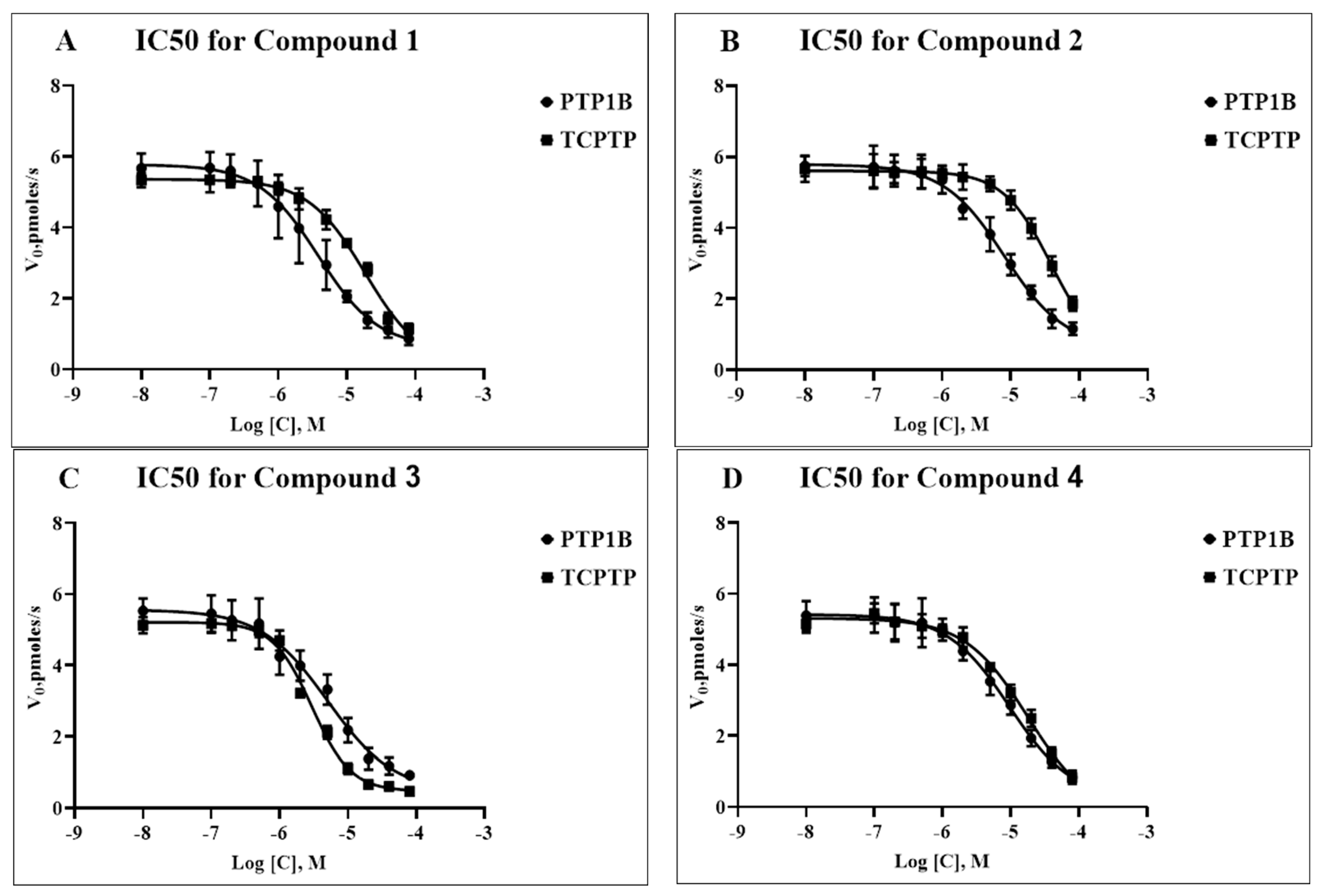

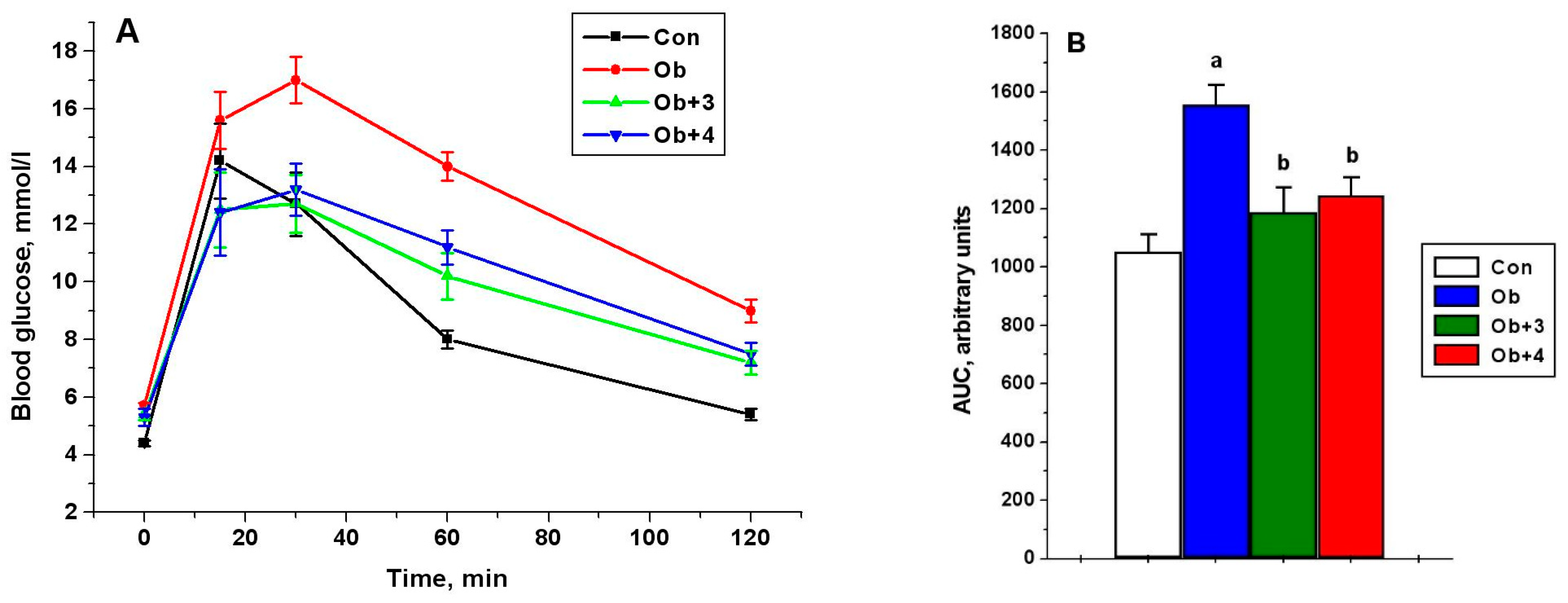


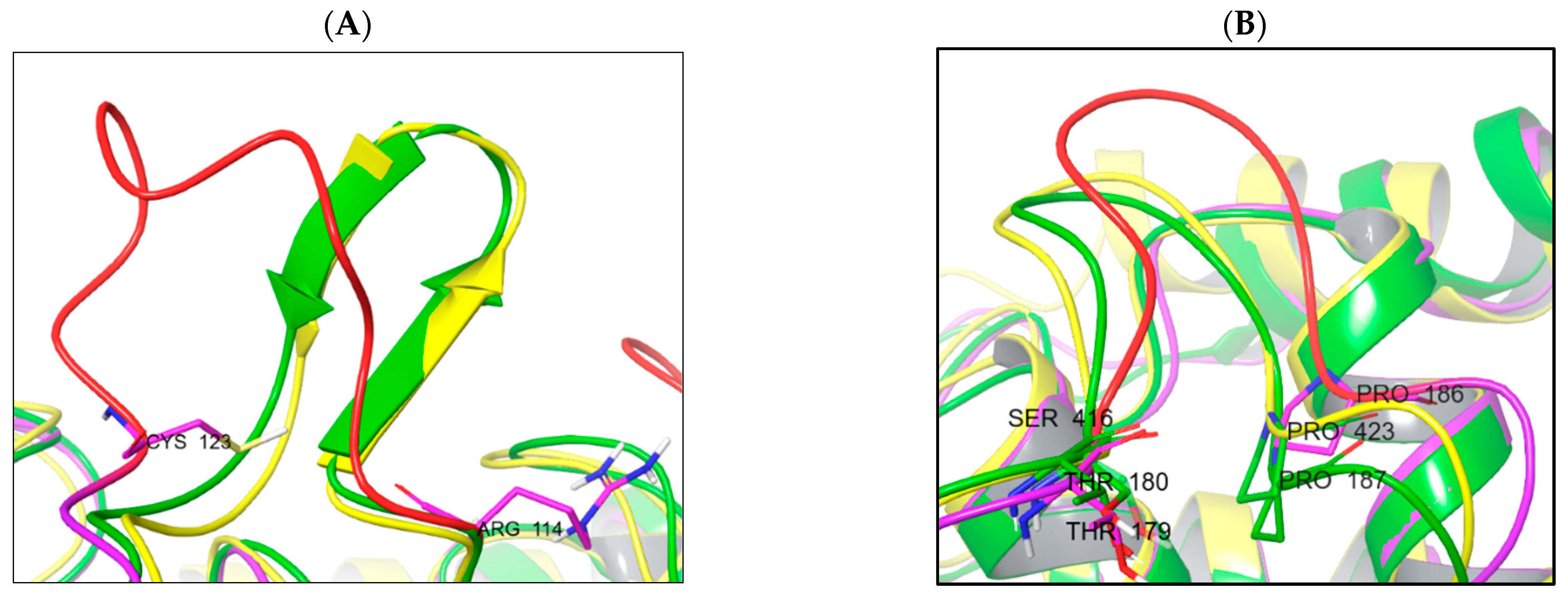
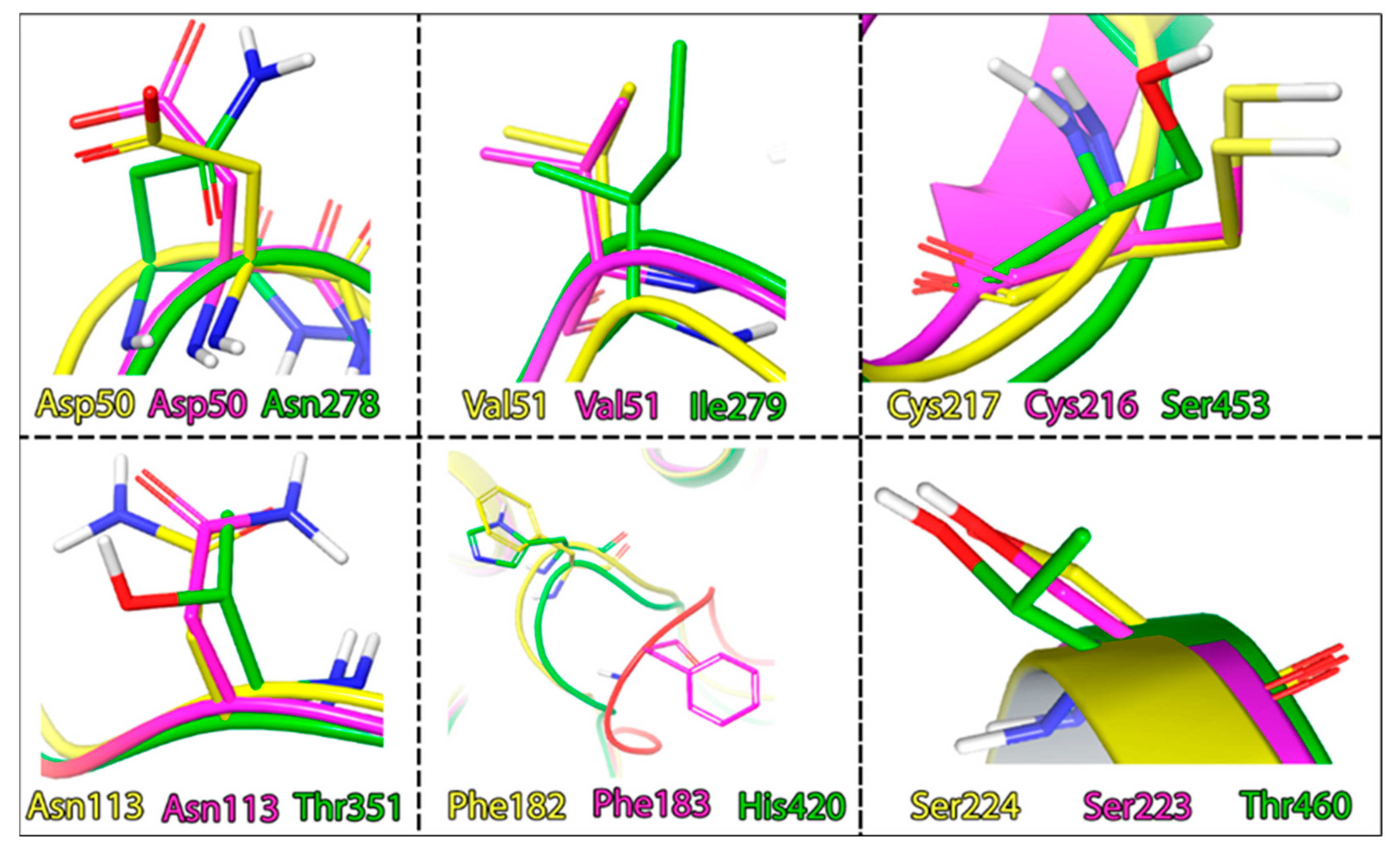

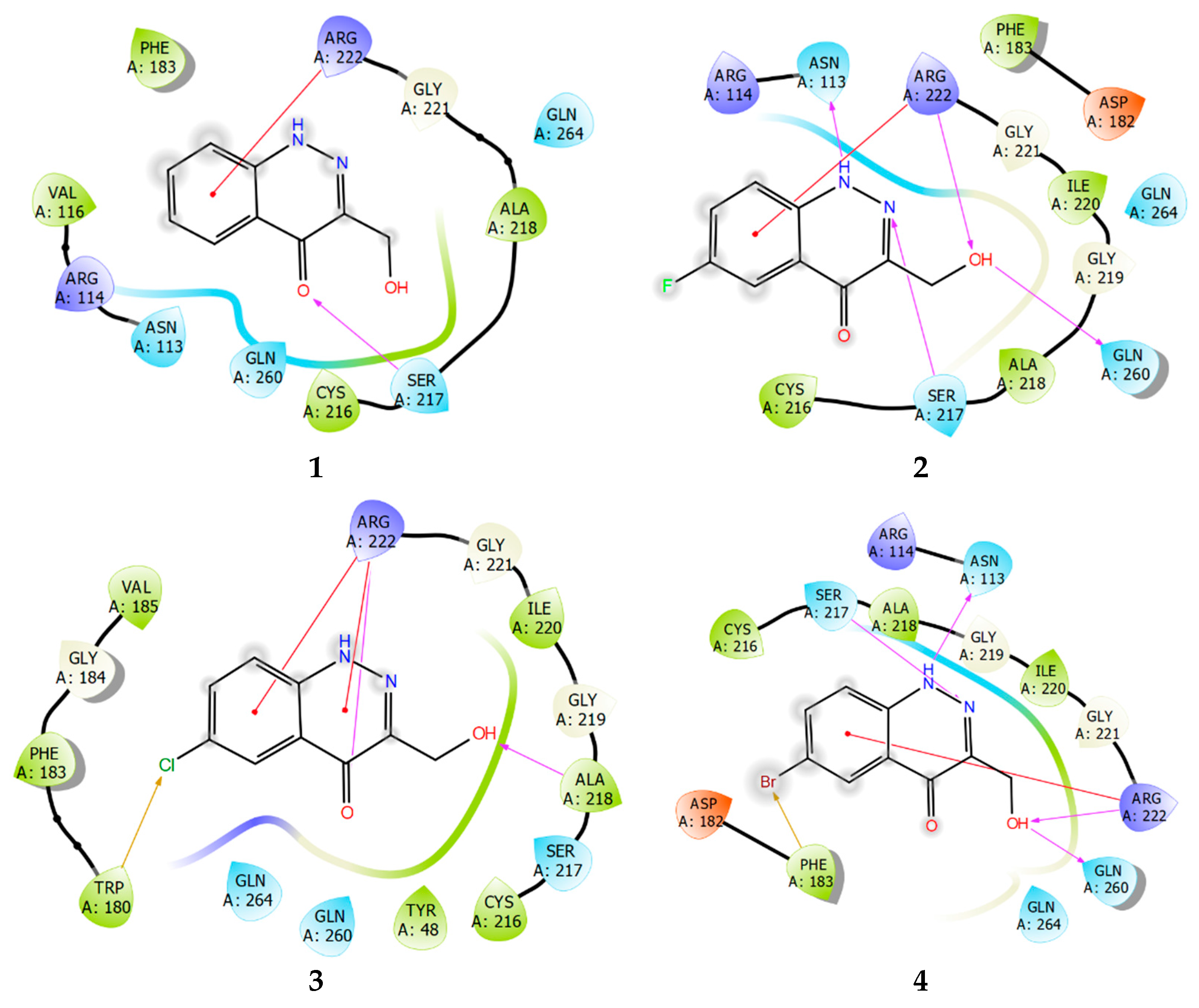
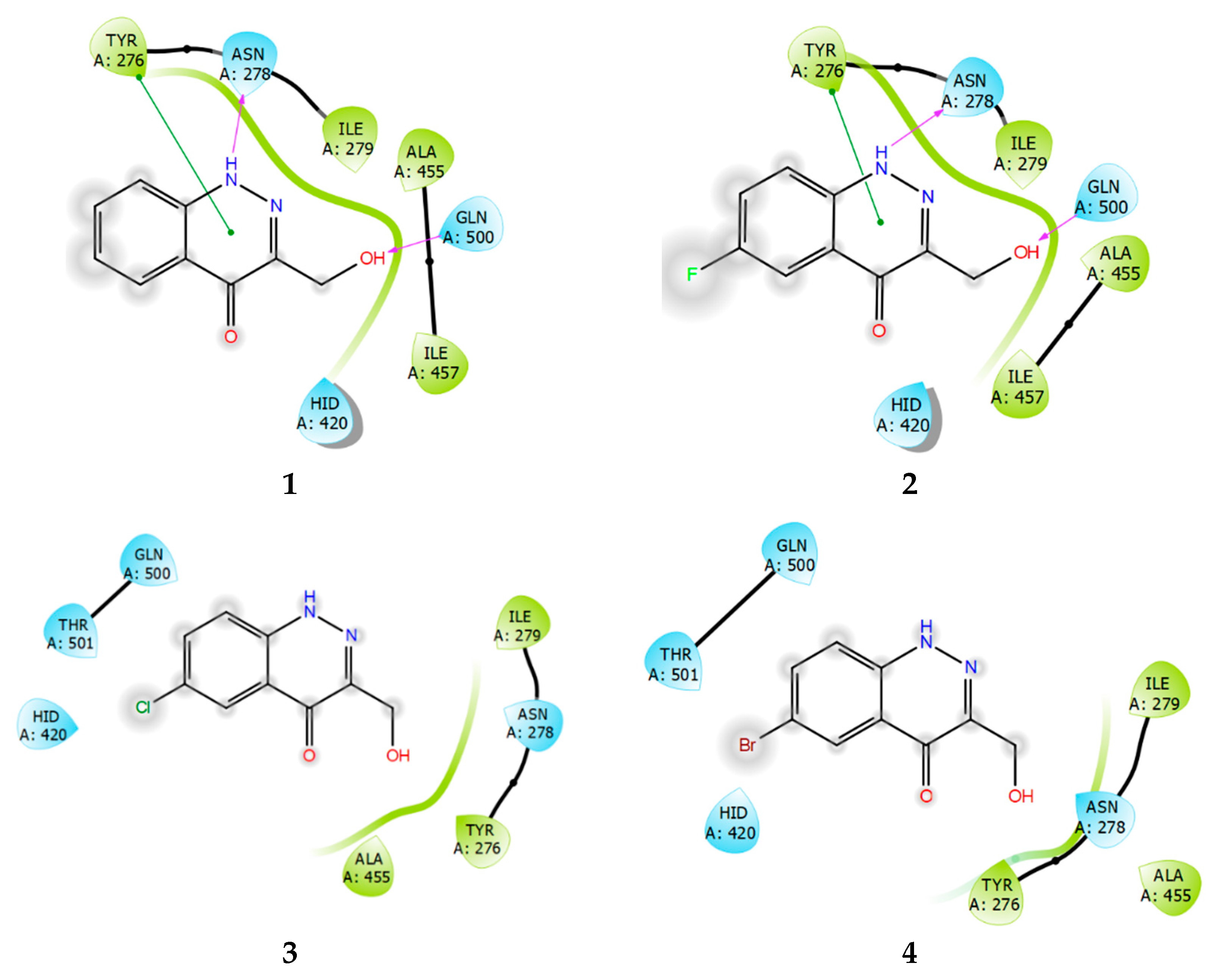
| Compound | PTP1B | TC-PTP |
|---|---|---|
| 1 | 3.78 ± 0.34 | 18.87 ± 2.06 b |
| 2 | 6.01 ± 0.59 | 42.79 ± 9.93 a,b |
| 3 | 5.11 ± 0.57 | 2.98 ± 0.76 |
| 4 | 11.04 ± 1.34 | 26.54 ± 4.66 |
| Group | Glucose, mM | Insulin, ng/mL | IR, arb.Units | Leptin, ng/mL | ||||
|---|---|---|---|---|---|---|---|---|
| Before | After | Before | After | Before | After | Before | After | |
| Control | 4.40 ± 0.15 | 4.24 ± 0.13 | 0.66 ± 0.07 | 0.64 ± 0.12 | 2.93 ± 0.38 | 2.73 ± 0.55 | 1.09 ± 0.12 | 1.06 ± 0.22 |
| Obese | 5.86 ± 0.13 a | 5.72 ± 0.19 a | 1.62 ± 0.11 a | 1.49 ± 0.18 a | 9.52 ± 0.75 a | 8.49 ± 1.07 a | 3.04 ± 0.29 a | 2.68 ± 0.26 a |
| Ob + 1 | 5.94 ± 0.22 a | 5.74 ± 0.07 a | 1.57 ± 0.16 a | 1.11 ± 0.14 a | 9.46 ± 1.31 a | 6.32 ± 0.77 a | 3.06 ± 0.40 a | 1.72 ± 0.24 b,c |
| Ob + 2 | 5.82 ± 0.22 a | 5.68 ± 0.09 a | 1.65 ± 0.17 a | 1.19 ± 0.13 a,c | 9.68 ± 1.27 a | 6.79 ± 0.76 a | 3.27 ± 0.38 a | 2.18 ± 0.22 a,c |
| Ob + 3 | 5.80 ± 0.31 a | 5.36 ± 0.31 a | 1.51 ± 0.18 a | 0.93 ± 0.13 b,c | 8.96 ± 1.46 a | 5.12 ± 0.97 b | 2.93 ± 0.42 a | 1.52 ± 0.21 b,c |
| Ob + 4 | 5.72 ± 0.30 a | 5.24 ± 0.25 a | 1.65 ± 0.18 a | 1.06 ± 0.13 a,c | 9.63 ± 1.57 a | 5.61 ± 0.89 a | 3.17 ± 0.25 a | 1.90 ± 0.16 a,b,c |
| Structure | Scores (kcal/mol) | ||||||||
|---|---|---|---|---|---|---|---|---|---|
| PTP1B | TC-PTP | SHP1 | |||||||
| GScore | MMGBSA ΔG | LE | GScore | MMGBSA ΔG | LE | GScore | MMGBSA ΔG | LE | |
| ref. | −8.36 | −83.78 | 0.28 | - | - | - | - | - | - |
| 1 | −6.02 | −41.48 | 0.46 | −4.93 | −31.28 | 0.38 | −4.36 | −23.80 | 0.33 |
| 2 | −6.40 | −41.43 | 0.46 | −4.78 | −33.08 | 0.34 | −4.19 | −21.61 | 0.30 |
| 3 | −5.94 | −43.74 | 0.42 | −4.60 | −40.06 | 0.33 | −3.76 | −18.06 | 0.26 |
| 4 | −5.59 | −44.17 | 0.40 | −3.98 | −38.42 | 0.33 | −3.77 | −18.29 | 0.27 |
| Genes | Forward/Reverse Sequence | Product Size (bp) | Annealing Temperature (°C) | Genbank |
|---|---|---|---|---|
| PTP1B | (For) CAACCGAGGAGGAACAAAAGG | 129 | 57 | NM_012637 |
| (Rev) CAGTCTGTCAGTGAAAACATACCCG | ||||
| TCPTP | (For) GTGGAAGAGAGCAGTGAGAGT | 216 | 56 | NM_053990 |
| (Rev) GGCTTCAGGTCTTGCTTTGC | ||||
| InsR | (For) CTGGAGAACTGCTCGGTCATT | 139 | 56 | NM_017071 |
| (Rev) GGCCATAGACACGGAAAAGAAG | ||||
| LepR | (For)GCATGCAGAATCAGTGATATTTGG | 81 | 57 | NM_012596 |
| (Rev) CAAGCTGTATCGACACTGATTTCTTC | ||||
| Shp1 | (For) CAGACTGTTCCCTCCACGTTT | 193 | 56 | NM_053908 |
| (Rev) TGGTCATCCACCCTGACTGA | ||||
| 18S | (For) GGACACGGACAGGATTGACA | 50 | 56 | NR_046237 |
| (Rev) ACCCACGGAATCGAGAAAGA |
Disclaimer/Publisher’s Note: The statements, opinions and data contained in all publications are solely those of the individual author(s) and contributor(s) and not of MDPI and/or the editor(s). MDPI and/or the editor(s) disclaim responsibility for any injury to people or property resulting from any ideas, methods, instructions or products referred to in the content. |
© 2023 by the authors. Licensee MDPI, Basel, Switzerland. This article is an open access article distributed under the terms and conditions of the Creative Commons Attribution (CC BY) license (https://creativecommons.org/licenses/by/4.0/).
Share and Cite
Derkach, K.V.; Gureev, M.A.; Babushkina, A.A.; Mikhaylov, V.N.; Zakharova, I.O.; Bakhtyukov, A.A.; Sorokoumov, V.N.; Novikov, A.S.; Krasavin, M.; Shpakov, A.O.; et al. Dual PTP1B/TC-PTP Inhibitors: Biological Evaluation of 3-(Hydroxymethyl)cinnoline-4(1H)-Ones. Int. J. Mol. Sci. 2023, 24, 4498. https://doi.org/10.3390/ijms24054498
Derkach KV, Gureev MA, Babushkina AA, Mikhaylov VN, Zakharova IO, Bakhtyukov AA, Sorokoumov VN, Novikov AS, Krasavin M, Shpakov AO, et al. Dual PTP1B/TC-PTP Inhibitors: Biological Evaluation of 3-(Hydroxymethyl)cinnoline-4(1H)-Ones. International Journal of Molecular Sciences. 2023; 24(5):4498. https://doi.org/10.3390/ijms24054498
Chicago/Turabian StyleDerkach, Kira V., Maxim A. Gureev, Anastasia A. Babushkina, Vladimir N. Mikhaylov, Irina O. Zakharova, Andrey A. Bakhtyukov, Viktor N. Sorokoumov, Alexander S. Novikov, Mikhail Krasavin, Alexander O. Shpakov, and et al. 2023. "Dual PTP1B/TC-PTP Inhibitors: Biological Evaluation of 3-(Hydroxymethyl)cinnoline-4(1H)-Ones" International Journal of Molecular Sciences 24, no. 5: 4498. https://doi.org/10.3390/ijms24054498
APA StyleDerkach, K. V., Gureev, M. A., Babushkina, A. A., Mikhaylov, V. N., Zakharova, I. O., Bakhtyukov, A. A., Sorokoumov, V. N., Novikov, A. S., Krasavin, M., Shpakov, A. O., & Balova, I. A. (2023). Dual PTP1B/TC-PTP Inhibitors: Biological Evaluation of 3-(Hydroxymethyl)cinnoline-4(1H)-Ones. International Journal of Molecular Sciences, 24(5), 4498. https://doi.org/10.3390/ijms24054498








